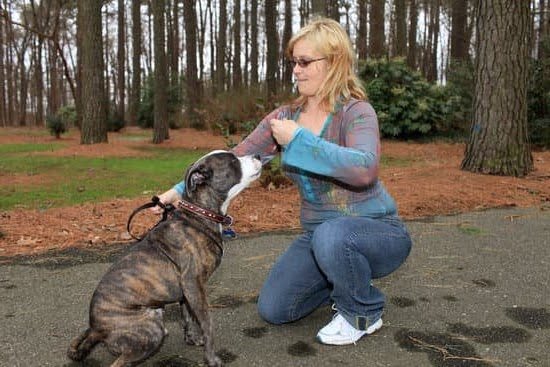Dogs are known for their loyalty, affection, and companionship, but training them can be quite a challenge. Understanding the mind of a dog and exploring their behavior is crucial in effective training.
In this article, we will discuss how to train dogs and the importance of positive reinforcement techniques in teaching them basic commands such as sit, stay, and come. We will also cover crate training, housebreaking, socialization, addressing behavioral issues, advanced training, and the keys to successful training: consistency and patience.
Exploring canine behavior is essential in understanding how dogs think and process information. By gaining insight into their instincts, body language, and communication cues, dog owners can better connect with their pets and create an environment that fosters learning and obedience. This section will delve into the psychology of dogs and provide valuable insights into their behavior.
The importance of positive reinforcement cannot be overstated when it comes to training dogs. Effective techniques such as rewards-based training have been proven to be more successful than punishment-based methods.
This article will explore the significance of positive reinforcement in shaping a dog’s behavior and building a strong bond between the owner and their pet. We will also discuss basic dog training commands like sit, stay, come, and more, highlighting how these can be effectively taught using positive reinforcement.
The Importance of Positive Reinforcement
The Power of Positive Reinforcement
Positive reinforcement is a crucial aspect of dog training. This technique involves rewarding your dog for displaying desired behaviors, which in turn encourages them to repeat those behaviors in the future. Rewards can be in the form of treats, praise, or toys. By using positive reinforcement, you are creating a positive association for your dog, making learning fun and enjoyable.
Clicker Training
One effective method of positive reinforcement training is clicker training. This involves using a small device that makes a clicking sound, followed by a reward for the dog. The click serves as a signal to the dog that they have performed the desired behavior, and a treat reinforces this message. Clicker training can be highly effective in teaching dogs new commands and behaviors.
Consistency and Timing
Consistency and timing are key components of positive reinforcement training. It is important to consistently reward your dog for good behavior every time it occurs. Additionally, rewards must be given immediately after the desired behavior is displayed so that the association between the behavior and the reward is clear to the dog. With patience, consistency, and proper timing, positive reinforcement can be an incredibly powerful tool in shaping your dog’s behavior.
By understanding and implementing these effective training techniques through positive reinforcement, you can build a strong bond with your furry friend while achieving successful results in their training journey.
Basic Dog Training Commands
Now that you understand the mind of your dog and have learned about the importance of positive reinforcement, it’s time to delve into basic dog training commands. Teaching your furry friend essential commands like sit, stay, come, and more is crucial for their safety and your peace of mind. Here’s how to train dogs and execute these commands effectively.
Teaching “Sit” Command
To teach your dog to sit, hold a treat close to their nose and then move your hand up, allowing their head to follow the treat and causing their bottom to lower. Once they are in the sitting position, say “sit,” give them the treat, and share praise.
Training Your Dog to “Stay”
To train your dog to stay in place, start with them in a sitting position. Hold out your hand with an open palm toward them as you say “stay.” Take a small step or two backward while rewarding them with a treat when they remain in place. Gradually increase the distance and duration before giving them the treat.
Recalling Your Dog With “Come”
The recall command is vital for keeping your dog safe in various settings. Begin by kneeling down, opening your arms wide, and encouraging your dog by saying “come.” When they respond positively by approaching you, reward them with a treat and praise for obeying the command.
By mastering these basic training commands with consistency and patience, you’ll establish a strong foundation for furthering your dog’s training capabilities. Always remember to keep sessions short and fun while using positive reinforcement techniques for successful learning experiences.
Crate Training and Housebreaking
When it comes to crate training, it’s important to make the crate a comfortable and inviting space for your dog. You can do this by placing their favorite blanket or toys inside the crate. It’s crucial to remember that the crate should never be associated with punishment – it should be a safe haven for your pet.
While housebreaking, take your dog outside regularly, especially after meals or naps, and reward them when they eliminate in the desired spot. Consistency is key during this process.
According to experts, crate training can take anywhere from a few days to a few weeks for dogs to get accustomed to it. Similarly, housebreaking may take several weeks before your dog fully understands where they should be doing their business. It is important to be patient during these processes as rushing through them can lead to setbacks in training.
| Topic | Timeframe |
|---|---|
| Crate Training | A few days to a few weeks |
| Housebreaking | Several weeks |
Socialization
One effective way to socialize your dog is by enrolling them in puppy classes or obedience training classes. These classes provide a structured environment for dogs to interact with other dogs and people under the guidance of experienced trainers. Additionally, regular trips to the dog park can also be beneficial for socializing your furry friend.
It’s important to introduce your dog to a wide variety of experiences during the critical socialization period, which typically occurs between 3 weeks and 14 weeks of age. However, older dogs can still benefit from socialization efforts. Remember that every new encounter should be positive and rewarding for your dog so that they learn to associate new experiences with good things.
| Socialization Method | Description |
|---|---|
| Puppy Classes/Obedience Training | Structured environment for dogs to interact with others under supervision. |
| Dog Park Visits | Opportunity for dogs to engage with different breeds and personalities. |
Addressing Behavioral Issues
Dogs, like humans, can display a wide range of behavioral issues that may frustrate their owners. Understanding the root cause of these problems is crucial in addressing and correcting them. Aggression, barking, and chewing are among the most common behavioral issues observed in dogs.
For many dog owners struggling with behavioral issues, the question of how to train dogs comma nds effectively is a pressing concern. The key to addressing aggression, barking, and chewing lies in employing positive reinforcement techniques and consistent training methods.
When it comes to tackling aggression in dogs, it is important to first identify the triggers that lead to aggressive behavior. Whether it’s fear-based aggression or possessive aggression, addressing the underlying causes through positive reinforcement and desensitization exercises can help modify this behavior over time.
Excessive barking can be a nuisance for both dog owners and their neighbors. To address this issue, it is essential to understand why your dog is barking excessively. Once the trigger is identified, using positive reinforcement to teach the “quiet” command and providing mental stimulation through activities such as puzzle toys can help reduce excessive barking. Additionally, consistency in training and patience are key factors in effectively curbing this behavior.
Chewing is a natural behavior for dogs, but destructive chewing can become problematic if not addressed early on. Providing appropriate chew toys and practicing crate training can help prevent destructive chewing habits. Using positive reinforcement techniques when redirecting your dog’s attention away from inappropriate items towards their designated chew toys can also aid in mitigating this behavior over time.
Advanced Training
When it comes to advanced training for your dog, teaching tricks and special skills can be both fun and rewarding. Not only does it stimulate your dog’s mind and build a stronger bond between you and your pet, but it also showcases their intelligence and abilities. Here are some advanced training tips on how to teach your dog tricks and special skills:
- Start with the basics: Before moving on to advanced tricks and skills, ensure that your dog has mastered the basic obedience commands such as sit, stay, come, and down. A strong foundation in these basic commands will make it easier for your dog to learn more complex tricks.
- Use positive reinforcement: Just like with basic training, positive reinforcement is essential when teaching advanced tricks. Rewarding your dog with treats, praise, or toys when they perform the desired behavior encourages them to continue learning and attempting new skills.
- Be patient and consistent: Advanced training may take more time and patience than basic obedience training. Be consistent with your expectations and practice sessions, always using the same cues for each trick or skill.
Once your dog has mastered the basic obedience commands, you can start introducing more challenging tricks such as rolling over, playing dead, or even fetching specific items by name. Remember that not all dogs will pick up on advanced tricks at the same pace, so be patient and enjoy the process of teaching your furry friend new skills. With dedication and positive reinforcement, your dog will thrive in their advanced training endeavors.
Consistency and Patience
In conclusion, training a dog requires a deep understanding of canine behavior and the use of effective techniques like positive reinforcement. Teaching basic commands such as sit, stay, and come are essential for building a strong foundation in your dog’s training. In addition, crate training and housebreaking will help create good habits in your pet.
Socialization is also crucial in helping your dog adapt to new environments and interact well with other animals and humans. Addressing any behavioral issues like aggression, excessive barking, or destructive chewing should be done with patience and consistency. It is important to remember that advanced training, such as teaching tricks and special skills, can be achieved through dedication and perseverance.
It is necessary to emphasize the importance of consistency and patience in dog training. By being consistent with your commands and expectations, and patient with the learning process, you will set your dog up for success. Keeping these keys in mind will ensure that you develop a strong bond with your pet built on trust and respect.
Remember that every dog is unique, so it’s important to be observant, adaptable, and most importantly patient throughout the training process. With this approach, you can achieve successful outcomes in how to train dogs comma nds.
Frequently Asked Questions
What Are the 7 Basic Dog Commands?
The 7 basic dog commands are sit, stay, come, down, heel, no, and leave it. These commands form the foundation of obedience training for dogs and are essential for their behavior.
What Is the Hardest Command to Teach a Dog?
The hardest command to teach a dog is often considered to be “stay”. It requires a lot of self-control from the dog to remain in one place without moving, especially when there are distractions around.
What Order Should You Train a Dog Commands?
When training a dog, it’s best to start with the most basic commands like sit and stay before progressing to more complex ones like heel or leave it. This helps the dog build a solid understanding of obedience before moving on to more challenging tasks.

Welcome to the blog! I am a professional dog trainer and have been working with dogs for many years. In this blog, I will be discussing various topics related to dog training, including tips, tricks, and advice. I hope you find this information helpful and informative. Thanks for reading!





